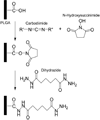Immobilization of glycoproteins, such as VEGF, on biodegradable substrates
- PMID: 18359670
- PMCID: PMC2587396
- DOI: 10.1016/j.actbio.2008.02.017
Immobilization of glycoproteins, such as VEGF, on biodegradable substrates
Abstract
Attachment of growth factors to biodegradable polymers, such as poly(lactide-co-glycolide) (PLGA), may enhance and/or accelerate integration of tissue engineering scaffolds. Although proteins are commonly bound via abundant amino groups, a more selective approach may increase bioactivity of immobilized molecules. In this research, exposed carboxyl groups on acid-terminated PLGA were modified with dihydrazide spacer molecules. The number of hydrazide groups available for subsequent attachment of protein was dependent on dihydrazide length, with shorter molecules present at significantly greater surface densities. The potent angiogenic glycoprotein vascular endothelial growth factor (VEGF) was oxidized with periodate and the aldehyde moieties allowed to react with the hydrazide-derivatized PLGA. Derivatization initially affected the amount of protein bound to the surfaces, but differences were substantially reduced following overnight incubation in saline. More importantly, use of shorter dihydrazide spacers significantly enhanced accessibility of immobilized VEGF for binding neutralizing antibody and soluble VEGF receptor. Furthermore, immobilized growth factor enhanced endothelial cell proliferation, with surfaces having the shortest and longest spacers stimulating greater effects. The present work has not only demonstrated an alternative approach to immobilizing growth factors on biodegradable materials, but the scheme can be used to alter the amount of protein bound as well as its availability for subsequent biointeractions.
Figures








Similar articles
-
The use of N-terminal immobilization of PTH(1-34) on PLGA to enhance bioactivity.Biomaterials. 2008 Jul;29(21):3137-42. doi: 10.1016/j.biomaterials.2008.04.019. Epub 2008 Apr 29. Biomaterials. 2008. PMID: 18448162 Free PMC article.
-
The phosphorylation of vascular endothelial growth factor receptor-2 (VEGFR-2) by engineered surfaces with electrostatically or covalently immobilized VEGF.Biomaterials. 2009 Sep;30(27):4618-28. doi: 10.1016/j.biomaterials.2009.05.030. Epub 2009 Jun 21. Biomaterials. 2009. PMID: 19540581 Free PMC article.
-
Defining conditions for covalent immobilization of angiogenic growth factors onto scaffolds for tissue engineering.J Tissue Eng Regen Med. 2011 Jan;5(1):69-84. doi: 10.1002/term.292. Epub 2010 Aug 17. J Tissue Eng Regen Med. 2011. PMID: 20717888
-
Immobilization strategy for optimizing VEGF's concurrent bioactivity towards endothelial cells and osteoblasts on implant surfaces.Biomaterials. 2012 Nov;33(32):8082-93. doi: 10.1016/j.biomaterials.2012.07.057. Epub 2012 Aug 11. Biomaterials. 2012. PMID: 22884814
-
Scaffolds with covalently immobilized VEGF and Angiopoietin-1 for vascularization of engineered tissues.Biomaterials. 2010 Jan;31(2):226-41. doi: 10.1016/j.biomaterials.2009.09.039. Epub 2009 Oct 2. Biomaterials. 2010. PMID: 19800684
Cited by
-
Angiogenic therapy for cardiac repair based on protein delivery systems.Heart Fail Rev. 2012 May;17(3):449-73. doi: 10.1007/s10741-011-9285-8. Heart Fail Rev. 2012. PMID: 21979836 Review.
-
Poly (lactic-co-glycolic acid) as a controlled release delivery device.J Mater Sci Mater Med. 2009 Aug;20(8):1669-75. doi: 10.1007/s10856-009-3727-z. Epub 2009 Mar 13. J Mater Sci Mater Med. 2009. PMID: 19283453
-
Tissue Engineered Neurovascularization Strategies for Craniofacial Tissue Regeneration.ACS Appl Bio Mater. 2022 Jan 17;5(1):20-39. doi: 10.1021/acsabm.1c00979. Epub 2021 Nov 29. ACS Appl Bio Mater. 2022. PMID: 35014834 Free PMC article. Review.
-
Cell-free vascular grafts: Recent developments and clinical potential.Technology (Singap World Sci). 2017 Mar;5(1):13-20. doi: 10.1142/S2339547817400015. Epub 2017 Mar 31. Technology (Singap World Sci). 2017. PMID: 28674697 Free PMC article.
-
Immobilization of bioactive vascular endothelial growth factor onto Ca-deficient hydroxyapatite-coated Mg by covalent bonding using polydopamine.J Orthop Translat. 2021 Sep 29;30:82-92. doi: 10.1016/j.jot.2021.06.002. eCollection 2021 Sep. J Orthop Translat. 2021. PMID: 34660198 Free PMC article.
References
-
- Caplan AI, Goldberg VM. Principles of tissue engineered regeneration of skeletal tissues. Clin. Orthop. 1999;367:S12–S16. - PubMed
-
- Han K, Choi M, Chung Y. Site-specific degradation and transport of recombinant human epidermal growth factor (rhEGF) in the rat gastrointestinal mucosa. Int. J. Pharm. 1998;168:189–197.
-
- Bastian SE, Walton PE, Belford DA. Transport of circulating IGF-I and LR3IGF-I from blood to extracellular wound fluid sites in rats. J. Endocrinol. 2000;164:77–86. - PubMed
-
- Sumner DR, Turner TM, Purchio AF, Gombotz WR, Urban RM, Galante JO. Enhancement of bone ingrowth by transforming growth factor-β. J. Bone Joint Surg. 1995;77A:1135–1147. - PubMed
-
- Lind M, Overgaard S, Nguyen T, Ongpipattanakul B, Bunger C, Soballe K. Transforming growth factor-β stimulates bone ongrowth. Hydroxyapatite-coated implants studied in dogs. Acta Orthop. Scand. 1996;67:611–616. - PubMed
Publication types
MeSH terms
Substances
Grants and funding
LinkOut - more resources
Full Text Sources

